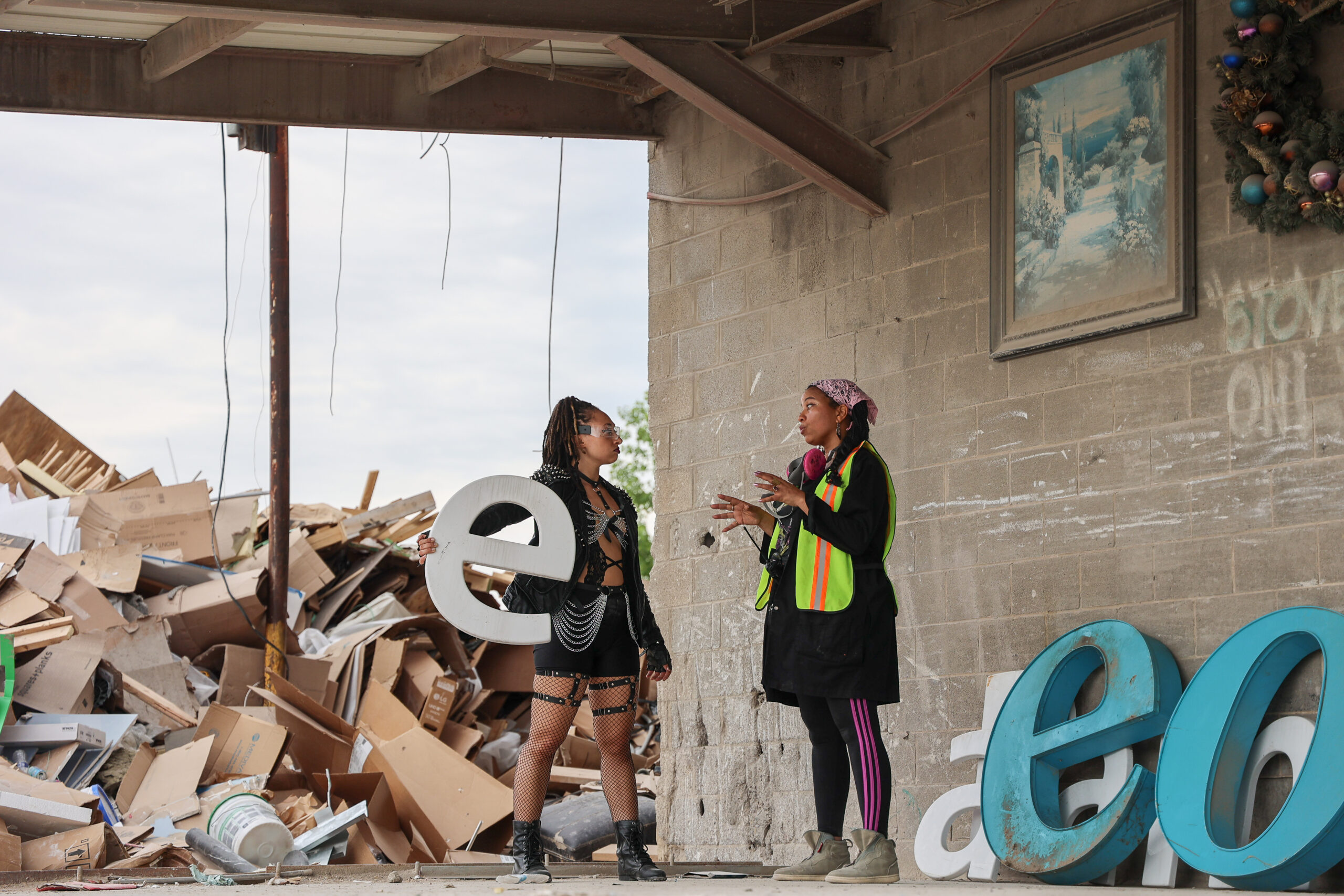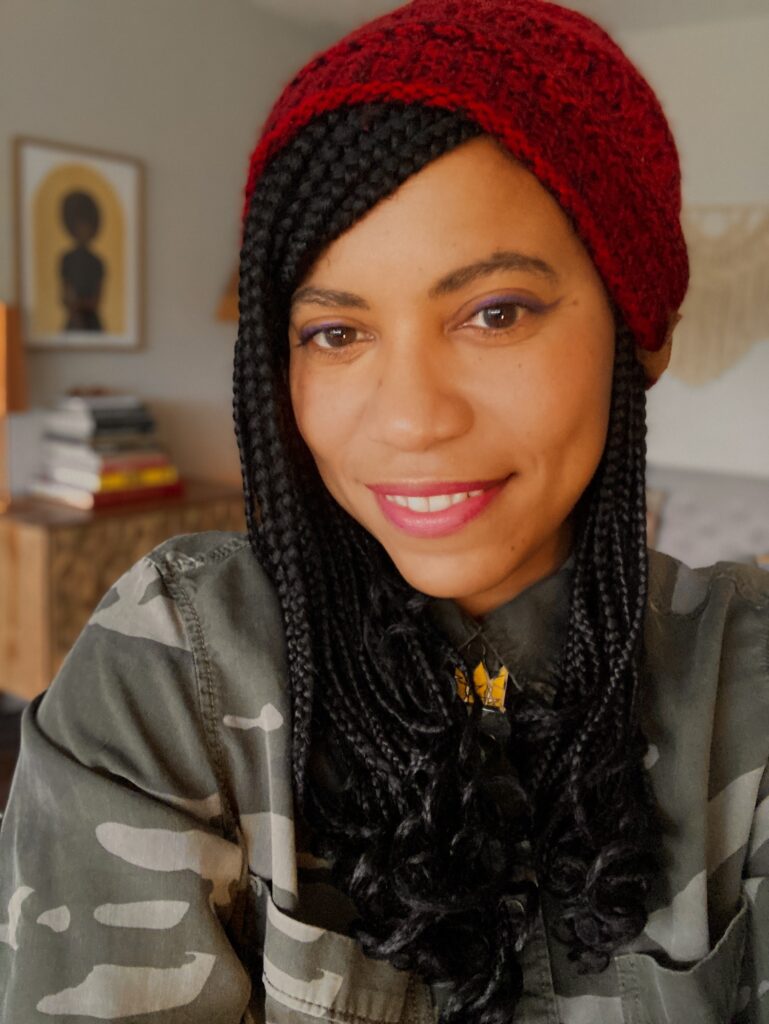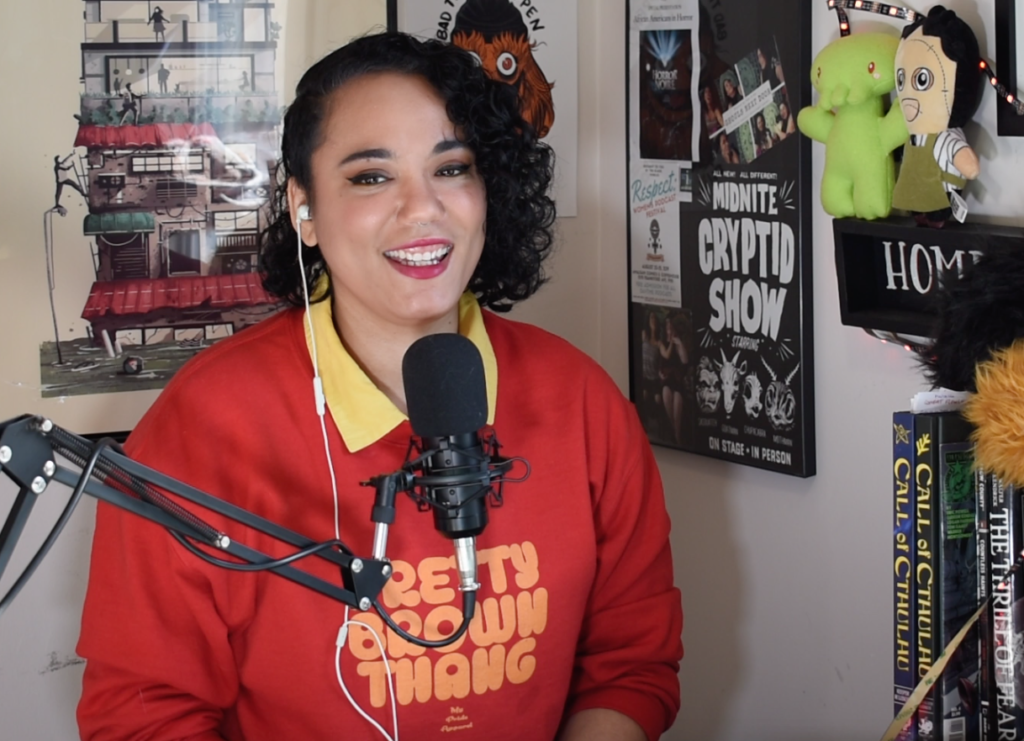
06 Jun Philadelphia Artist Spotlight: Li Sumpter
BY GABE CASTRO
The cinéSPEAK Journal publishes a monthly Philadelphia Artist Spotlight highlighting local filmmakers and moving image artists doing unique and impactful work.
Li Sumpter has a vision for the future and it is one of hope and inspiration. Sumpter is a mythologist, a multidisciplinary artist, and an independent scholar who applies strategies of worldbuilding and mythic design toward creating better, more resilient communities of the future. Motivated by the art of survival, sustainability, and resilience, she focuses her creative research and collaborative designs on diverse ecologies and immersive stories of change. Through her work as producer and eco-arts activist with MythMedia Studios and the Escape Artist Initiative, she collaborates with BIPOC creators focused on building community by creating and saving space for creators like them.
Her work affirms the existence of Black people and culture in the future. Science fiction has historically lauded works that envision a monolithic future void of humanity’s diversity. Afrofuturism is a genre of work that counters these envisioned futures and reclaims a liberated future for Black life. Her recent project envisions such a future here in her hometown of Philadelphia. Graffiti in the Grass is an Afro-apocalyptic myth set in future Philly 2045. The film follows Roxanna “Roxi” RedMoon, a young woman of African and indigenous descent, who finds herself on a mission to find her missing sister. On this journey, she discovers that she may need to save the planet on the eve of a cosmic catastrophe. Graffiti in the Grass is a transmedia narrative using different platforms to convey the story including mobile apps, graphic novel, escape room, mixtape, and an immersive theatrical experience on stage.
When not creating immersive experiences of a hopeful, inspiring future, Sumpter is educating creatives about the power of storytelling by teaching courses for youth and adults in myth, world-building, and Afrofuturism at the Pennsylvania Academy of the Fine Arts (PAFA), Fleisher Art Memorial, The Barnes Foundation, Haverford College, and Moore College of Art and Design. She can also be found at Monument Lab, Painted Bride Art Center, and RADIOKISMET working on various interdisciplinary projects. Sumpter is currently working on a new project titled Illadelph Dreams, which is an extension of Graffiti in the Grass, told through the eyes of an A.I. service model polyglot designed for linguistic translation (The Aeon 8) and will be coming to a Philly theater stage in the Fall of 2023. In this new chapter, Illadelph follows Luka, an Aeon 8 and reluctant member of an underground colony of humanoids planning to revolt against their human makers.
cinéSPEAK asked Sumpter about the themes in her work, what inspired her recent film, and how her art continues to grow.

cinéSPEAK: What inspired you to be a media artist?
Li Sumpter: The moment I understood what the combined power of myth and the movies could do to create an unforgettable, transformative story–one that resonates long-term with audiences on a whole other level–I knew I wanted to make what I call “mythmedia.” I grew up a Star Wars fan wearing my hair in buns and believing in The Force. I used to (and still do) keep a steady watch on the skies hoping to witness a close encounter of the Third Kind. Science fiction, and more specifically, worlds of the near and speculative futures, deeply impacted my perspective on reality and the way I saw the world and my place in it.
This continued into young adulthood when I spent an unusual number of hours contemplating the existence of the Matrix, time travel, and the impending apocalypse. When I realized how strongly my imagination and my waking life were influenced by the media I consumed, I decided to see what that relationship was all about. I ended up in a doctoral program in Mythological Studies and Depth Psychology at Pacifica Graduate Institute. I wrote my dissertation on the impact of apocalyptic film and images on individual and collective consciousness. After studying mythic models, story frameworks, and archetypal “force” fields, I set out to create my own myths and story worlds applying all I learned and loved about mythos and the movies. Enter: Graffiti in the Grass.
cinéSPEAK: What is the intent of your project Graffiti in the Grass and what themes do you explore in your work overall?
LS: The story of Graffiti in the Grass is designed to center the lives and voices of communities of color often overlooked and underserved in response and relief efforts in social, economic, and environmental crises. As a trauma-informed project, Graffiti in the Grass considers the experiences of victims and survivors of violence as well as those suffering from anxiety and PTSD rooted in our own fears and nightmares about the future.
Illadelph and the overarching transmedia epic of Graffiti in the Grass explore themes of oppression and liberation, solidarity, and survival. The epic digs deep into questions about the nature of technology and the human soul and what it truly means to be alive in 2045. Inspired by some of the iconic films from my youth and speculative stories like Blade Runner, Terminator, Brazil, Purple Rain, The X Files, and The Wiz, the Graffiti series also taps into issues of ecology and (un)natural disaster, race and technology, the power of empathy, and literacy as a tool for survival and worldbuilding.

cinéSPEAK: How has Philadelphia influenced you and how do you hope your work impacts Philadelphia in return?
LS: It feels safe to say that any Philly artist true to the love and grit that’s shaped them will at least credit, if not honor, this city in their art. Whether we hold good, bad, ugly, or crazy beautiful memories of our time here, those of us who proudly claim or cosmically connect to Philly know the soul of this city is undeniable. I’d be among the first to say it can be a raw and violent place. But it’s also the home of new beginnings, underdog heroes, and sacred monuments. It’s a place where everyday and otherworldly stories alike are born from the dark cracks of concrete walls and cobblestone streets.
So many Philly artists have a homegrown story to tell. Illadelph Dreams is my story–the once and future-Philly tale I want to tell through my own mind’s eye. It’s a speculative vision of an apocalyptic future–but hope, healing, and the art of survival inform the message of this myth. I can’t imagine this story being told without shining a light on the art, issues, and voices that define and color the archetypal Philly of my dreams. The people and places that make Philly home to me and keep me believing in this town no matter how tough it gets are essential to my world-building process for Illadelph Dreams. Like all my work, this project is deeply collaborative. Without the contribution and inspiration of my surrounding creative and activist communities, the heart of this story would flatline.
I hope this story will play just a small part in shifting Philly’s collective mind and daily experience away from this cycle of violence that has us all entangled in an endless death roll. I want to ignite our wildest dreams and highest hopes for this city and all who call it home with a focus on communities of color. The title, Illadelph Dreams, is not only about the many stories, dreams, and nightmares that shape the soul of this city. It’s also about the power and purpose of the city itself–the living, breathing archetype of “Illadelph”–its fate in the near future, and its prophesied role in saving humanity and the planet.
What if the city was alive and could imagine its own future? What would “Illadelph Dream”? How would it protect itself and its people from the horrors of [the] apocalypse?
For many Afrofuturists and speculative storytellers of color, oftentimes the impetus for worldbuilding is the agency and freedom that comes with radical imagining and racial representation in the media. As Octavia E. Butler and Samuel R. Delany remind us, there’s great power in creating our own images and stories of tomorrow. As a mythologist, I’ve come to understand that myths are not the antithesis of truth. On the contrary, as cultural systems of belief, they are the psychic foundation for the reality that give rise to the structures of society and the way we live. With this understanding in mind, I think it’s up to us–artists, storytellers, and media makers–to make future myths about us we can believe in and one day make a reality. It’s my hope that Illadelph Dreams is one of these new myths among many.
Follow Sumpter on Myth Media’s social media (@mythmediastudios) to keep up with the evolution of Graffiti in the Grass and the pending premiere of Illadelph Dreams.
*Featured Image: Image from Li Sumpter with collaborating artists Tanner Hicks, Caitlin Green, M. Asli Dukan, and Ken McFarlane for MythMedia Studios/Illadelph Dream test shoot @ RAIR. Image credit: Andrea Walls.
This article was originally published on June 6, 2023. Images updated on June 8, 2023.
Would you like to be featured in a future spotlight? Please fill out the Philadelphia Artist Spotlight form. The cinéSPEAK Journal maintains sole discretion over the publishing of any information provided via the form. Questions: journal@cinespeak.org

Gabe Castro is a Philadelphia-based Latiné multimedia professional specializing in the horror genre. Gabe believes media can be used as a tool to bring social change and works in all she does to create impactful and inspiring media.

Sorry, the comment form is closed at this time.